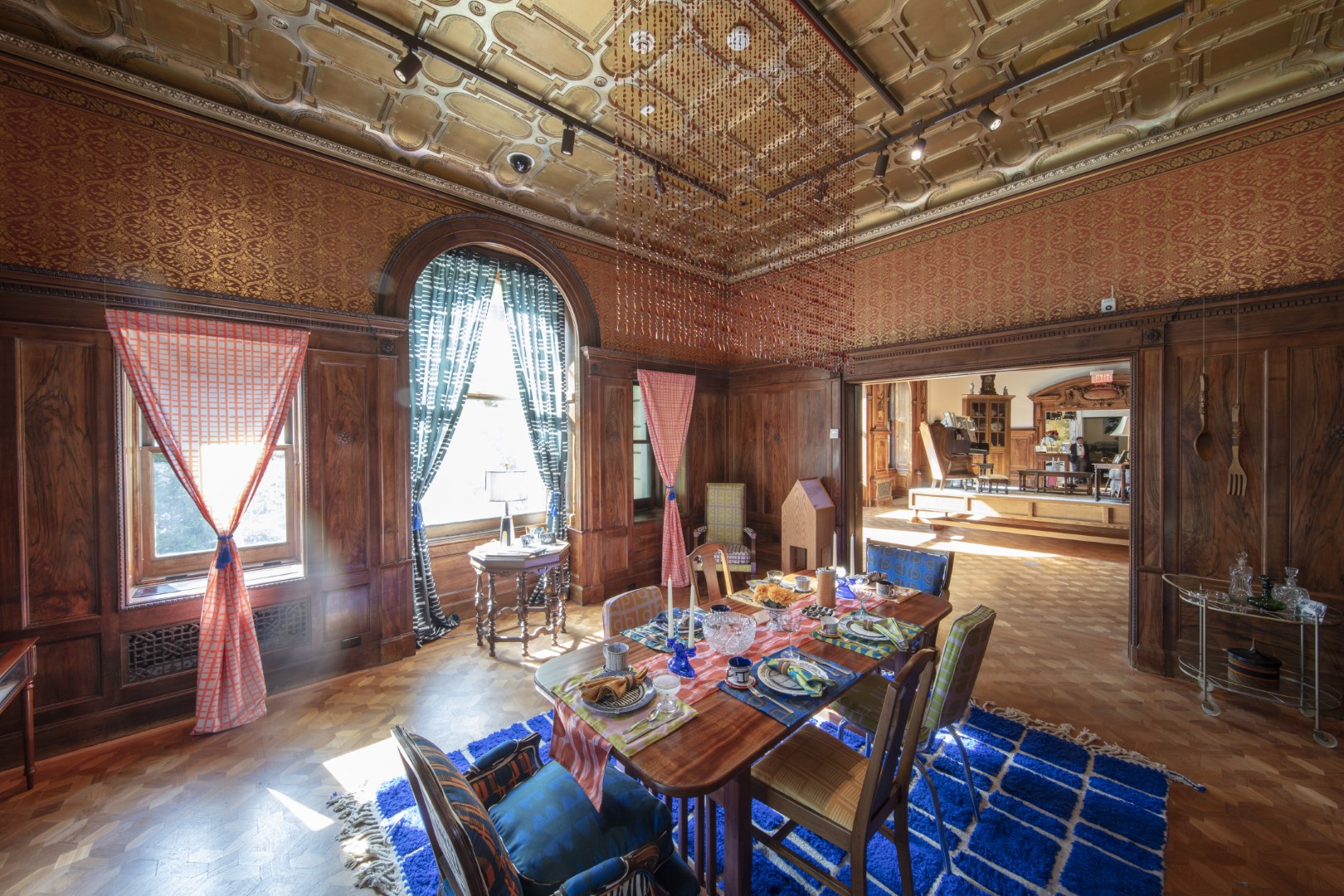THE OFFERING

ABOUT THE INSTALLATION
NICOLE CROWDER
BORN 1985, NUREMBERG, GERMANY; ACTIVE SAINT PAUL, MINNESOTA
HADIYA WILLIAMS
BORN 1978, WASHINGTON, DC; ACTIVE WASHINGTON, DC
Hadiya Williams is a multidisciplinary designer with experience in graphic arts, surface design, and ceramics. Nicole Crowder is known for her upholstery and furniture designs. Their collaborative installation The Offering presents a vignette of Black family life centered upon a dining room. The six place settings and chairs around the table are references to the six decades, from 1910 to 1970, during which record numbers of African Americans departed the US South for northern states as part of the Great Migration. The tablescape and room are meant to evoke a landing space, recalling moments of arrival for African Americans who undertook these migrations and found refuge in places to stop and gather. Through the act of homemaking, Crowder and Williams’s “offering” recalls how mementos, carried along the journey to a new home, could reconnect families and provide a sense of belonging amid disorienting displacement. The geometric textiles suggest routes and patterns of movement, while lushly upholstered seats and handmade ceramic objects function as portals into past home lives.
You are welcome to sit on the settee and the chair on the perimeter of the room.
Visual Description
The Offering sits in what was Andrew Carnegie’s breakfast room. The room is warm and detailed parquet flooring, wood paneled walls, a green marble fireplace, arched windows, and intricate gold ceiling—the epitome of Gilded Age opulence. The furniture, however, is contemporary, creating a tension between past and present.
In the middle of the room is a mid-century modern dining set, placed on a plush area rug with a cobalt blue square pattern. The electric blue of the rug contrasts brightly with the warm oranges, browns, and golds of the room, creating a focal point for the installation. Carefully curated mis-matched chairs with bright geometric patterned cushions encircle the long rectangular wooden table and represent different decades of the Great Migration.
On top of the table is a trove of colored glass, oblong coups, textured ceramic dinnerware set against polished patterned porcelain, and bold graphic textiles. Each place setting is unique and neatly arranged but vibrates with various colors and patterns. Despite the visual feast, the table is conspicuously empty of food, libations, and company. Poised, polished, and ready to be populated—these seats are reserved
Hung above the table is a curtain of orange plastic beads. A singular row running the length of the table with teardrop-shaped beads sparkling under the gold ceiling’s track lighting.
The rest of the room is decorated with a few carefully chosen items including a round wooden table topped with a lamp, picture frames, and “Ebony” and “Black Scholar” magazines; a glass display cabinet featuring a photo album with pages full of family photos; a love seat; an upholstered chair; a side table with a white rotary phone; a bar cart with glassware; a glass hutch filled with dinnerware, photographs, a teapot, a Bible, and other objects; a large wooden fork and spoon; and a black-and-white photograph of a Black couple dancing framed above the mantel. Much like the dining set, the furniture and personal effects are lived-in and tasteful.
Acknowledgements
Textile design, clay work, and installation by Hadiya Williams, Black Pepper Paperie Co. Upholstery, fabrication, and installation by Nicole Crowder, Nicole Crowder Upholstery. Research by Kimberly E. Springle, GTMS Legacy Enterprises, public historian and cultural preservationist. Dining table fabrication by Lawrence Moore, Heavy Paper Co. Book and historical magazines provided by BLK MKT Vintage. Textile printing by Spoonflower. Curtain fabrication by Soraya Wright. Hutch and radio by M.O.B Vintage, Washington, DC.
This installation is made possible with additional support from F. Schumacher & Co.